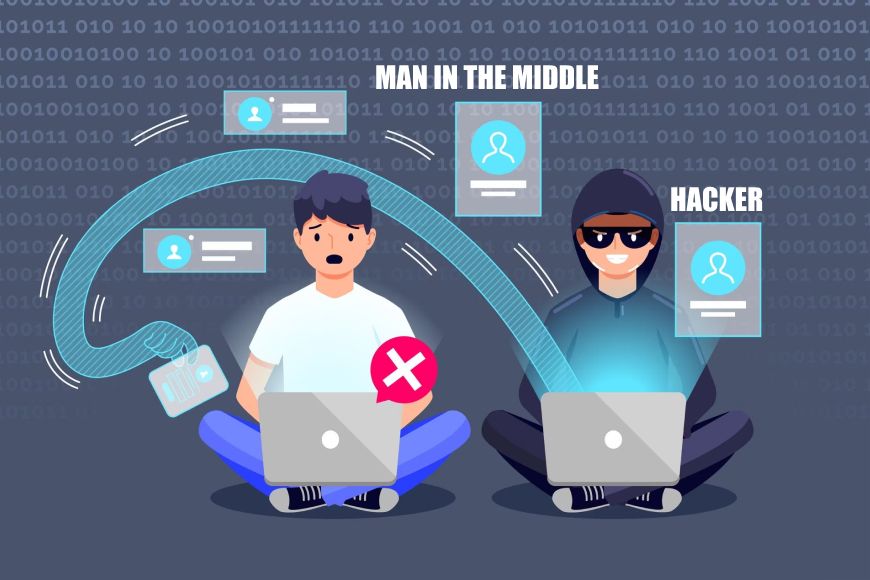Imagine you're passing a secret note to a friend in class, but someone in the middle snatches it, reads it, and might even change some of the words before passing it on. Frustrating, rather creepy, right? Now imagine this malicious eavesdropping in action on the internet when you interact with your online banking website or email services and exchange sensitive information. This is precisely where the remarkable features of ExpressVPN for online security shine.
That’s a Man-in-the-Middle attack. I know what you’re probably thinking. It sounds like something out of a spy novel, but it's a real threat that can have serious consequences. And there are so many things you may not know about these attacks. Many attacks are essentially designed to intercept your communications, steal your personal information (passwords, credit card numbers, bank account details), and even take control of your devices.
In this article, we’ll discuss MITM attacks, how they work, hacker’s motives, and the most important part - how you can protect yourself from them.
What is Man-in-the-Middle Attack?
At its core, a MITM attack is a form of digital deception. Consider the attacker as a smart eavesdropper who listens in on a private conversation between two people, intercepts it, and can even manipulate the conversation to serve their bad intentions.
Imagine two individuals, Alice and Bob, communicating over what they believe is a secure channel. Unknown to them, an attacker, let’s call them Eve, positions herself between the two. Alice and Bob think they're communicating directly with each other, but in reality, every word they exchange is being passed through Eve.
The attacker can now do multiple things:
- Listen to private conversations to get some valuable information.
- Steal sensitive data being shared between the parties.
- Modify the messages being exchanged.
This could be as subtle as changing a bank account number in a transaction detail or as blatant as delivering entirely false information. Every piece of information, every login credential, every transaction detail shared on this network could potentially be intercepted and manipulated by the attacker.
How Man-in-the-Middle Attacks Work
Understanding the mechanics and different methods of MITM attacks is essential to recognizing and preventing them. Here's a breakdown of how MITM attacks work, spotlighting various techniques attackers employ.
Email Hijacking
Email is a primary mode of communication, especially for businesses. And where there's communication, there's a goldmine of data that these cybercriminals cannot wait to intercept. In email hijacking, attackers gain unauthorized access to trusted entities’ email accounts, such as banks or financial institutions. To fortify your email security, consider employing the best VPN services available, adding an extra layer of protection against potential threats.
Once inside, they can monitor transactions and correspondence, gleaning sensitive information. In more sinister moves, they may fake or "spoof" the bank’s email address, sending instructions to unsuspecting customers. These might include requests to resend credentials or even transfer money to an attacker-controlled account.
Wi-Fi Eavesdropping
Public Wi-Fi networks, with their convenience, can also be traps. Here's how Wi-Fi eavesdropping operates. Cybercriminals set up rogue Wi-Fi networks with legitimate or enticing names. This could mimic a nearby café's network or bear a generic tag like "Free Public Wi-Fi". Unsuspecting users connect to these networks, thinking they're safe. Once connected, every piece of information they share, browse, or send can be intercepted and stolen. To stay secure, consider using the fastest VPN services available when connecting to public Wi-Fi networks, adding a crucial layer of protection against potential eavesdropping threats.
DNS Spoofing
Every website you visit has a unique address, translated from human-friendly URLs to IP addresses by the Domain Name System (DNS). In DNS spoofing, attackers intercept these DNS queries. They provide false IP addresses in return. This misdirection takes users to malicious websites, often mirror images of the legitimate ones, tricking users into providing sensitive information.
Session Hijacking
Online, your activities within a website, especially logged-in sessions, are often tracked using session tokens or cookies. In session hijacking, attackers steal a user's session token. With this token, they can impersonate the user, gaining unauthorized access to accounts and potentially making unauthorized changes or transactions.
SSL Hijacking
SSL (Secure Sockets Layer) is a protocol ensuring secure connections. SSL hijacking is especially concerning as it targets this security layer directly. When devices establish an SSL connection, a "handshake" occurs to decide encryption standards. Attackers intercept this handshake. They force the connection to use a weaker encryption standard, one they can easily break, allowing them to access the transferred data. To bolster your online security, you might also want to consider using the Best Free VPN services available, further enhancing your protection against SSL hijacking and similar threats.
In essence, while the methods vary, the core of a MITM attack remains consistent: unauthorized interception with potential data manipulation.
Preventing Man-in-the-Middle Attacks
With a combination of awareness, technological tools, and best practices, one can significantly reduce the risks associated with MITM attacks.
Prioritize HTTPS Over HTTP
The "S" in HTTPS stands for 'Secure.' When you see this in your web browser's address bar, it indicates that the data you exchange with the website is encrypted. Always check for "HTTPS" before the website's address, especially if you're sharing sensitive information like passwords or credit card details. Sites without HTTPS lack this encryption, making them prime targets for attackers.
Virtual Private Network (VPN)
VPNs are like private tunnels in the vast world of the internet. They encrypt your data, making it extremely difficult for malicious entities to decipher any intercepted information. To get started on your journey to online security, consider a reliable VPN service. This guide to creating a VPN will walk you through the process step by step. Activate it, especially when browsing on public networks, ensuring your online activities remain private and secure.
Update, Update, Update!
Software developers regularly patch vulnerabilities in their software. By not updating, you're essentially using software with known weak points, making you an easier target. Regularly check for and install updates for your operating system, web browser and any other software. Enable automatic updates if possible.
Beware of Public Wi-Fi
Public Wi-Fi networks, often found in cafés or airports, are usually unsecured. This means they're easier for attackers to exploit. If you must connect to public Wi-Fi, always use a VPN. Avoid activities that involve entering sensitive information. When in doubt, use your mobile data.
Endpoint Security Software
Endpoint security software safeguards your devices by detecting, blocking, and eliminating potential threats. They play a pivotal role in ensuring the devices you use to connect to the internet are free from vulnerabilities. Choose robust endpoint security software like Avast, Sophos or Bitdefender and keep it updated.
Last but not least, ensure the endpoint security software you choose includes features like real-time scanning, firewall protection and regular system checks.
Stay vigilant, stay safe!

